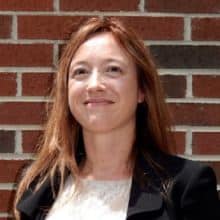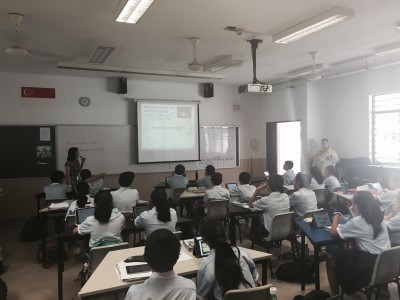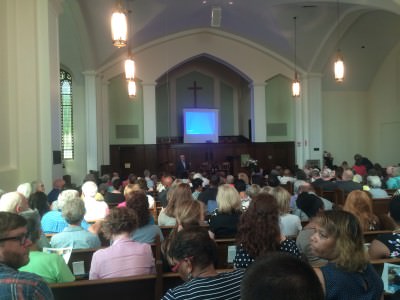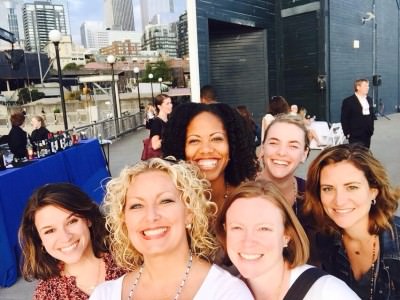In 2013, the term “selfie” was designated as word of the year by the Oxford English Dictionary. Selfies are single photographs taken of oneself, typically taken with a smartphone or webcam and uploaded to a social media website. Ken Geiger, deputy director of photography of National Geographic, says, “it’s not about making your picture. It’s to show yourself in a situation.”
With this concept in mind and using STEM applications, teachers can capture that situation where the light of learning shines on the student’s face.
As a teacher of academically gifted students, I often have the opportunity to work with classroom teachers. In Carteret County, Kristin Lupton and I worked together to develop and deliver lessons recognizing the multiple learning styles of the diverse students in her 7th grade English class.
Working with Lupton to incorporate STEM learning into her English classroom, we found many opportunities to extend and infuse multiple learning disciplines as we taught the play, “Our Town.” In exploring the concept of our town, we expanded our students’ individuality and promoted the collective learning community established by our students. And, we infused digital literacy with dramatic elements using selfies.
Purpose design, authentic application
The play “Our Town” by Thornton Wilder dramatically portrays the potential we each have in designing our lives, should we choose to accept the challenges and successes. Lupton and I chose to teach “Our Town” to scaffold context for our seventh graders – seventh graders whom struggle with authentically expressing their best self.
Chat, snap, delve
For Lupton’s classes, we taught this play with our academically gifted classes because we have more access to those classes for collaboration, because the students are more familiar with flexible grouping, and because of the advanced content of Wilder’s play.
We moved the students into small groups based on strengths they exhibited, focusing on interpersonal and extrapersonal skills. Our students discussed what factors make up positive relationships within a community like the one in “Our Town.”
We handed each student an iPad and practiced taking selfies. We guided the students individually, asking how each reflected them as individuals and what it showed about their personal characteristics. Then we took a walk.
iPads in hand, we headed for a tour of the school where students naturally hammed it up in front of the camera in selfies, pictures with their groups, shots with their teachers, and larger photo-bombs.
Back in the classroom, the small groups sorted through the images, learning that: a) the self could be represented in images; b) our class worked as a small community finding the best ways to represent itself; and c) qualities of successful communities could be identified in these images.
Our class was “Our Town.”
Lights, camera, reactions from students
Our goal was to demonstrate how the community dramatically constructed in Wilder’s “Our Town” correlated to the community of learners within a class. Anthony demonstrated the success of this task when he offered, “I am and am not like everyone else – we are all common.”
The targeted use of technology in the English classroom is increasing.
Students in Lupton’s class recognized that using technology and literacy to cultivate an understanding of dramatic elements is rare. STEM in the English classroom offers students ways to reach curriculum objectives in unexpected ways.
Action: cut to the drama
The distinguishing factor for great learning is relevance – how one sees themselves in his or her own learning. When harnessing that learning to not only heighten personal learning – but also holistically heighten the learning community – synergy strikes.
This synergy is what we want as teachers in our classroom.
To reach that goal we must extend our classrooms beyond curriculum and we must empower students with multiple ways to reach objectives.
Engaging multiple learning styles through the use of STEM applications allows for a collaborative learning environment for students guided by their teacher.
Additionally, while students may be digital consumers, they may not necessarily be digitally literate. STEM collaborations within a school improve student literacy by channeling student strengths that may not be traditionally expressed. Exploring solutions together cultivates the learning community in ways that promote empathy and positive student performance.
STEM can bring engagement to the classroom
The science, technology, engineering, and mathematics that cultivate a synthesis of learning also denote strategy, team-building, engagement, and motivation that can only be obtained by working collaboratively.
Teachers can collaboratively design lessons that promote authentic student engagement and formative performance tasks. Principals and other building and district-level administrators should support innovative ideas like the collaboration between Lupton and I. Using STEM applications, our class identified the community our class had become through collaborative learning practices. As one student, Macy, stated in reaction to this lesson, “selfies can be blurry while being most creative.” This is what STEM and literacy does – allows the teacher to let abstract concepts shine light to promote concrete learning.




